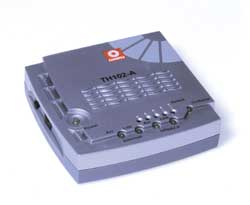Digging into Phoneline Networking and HomePNA 2.0
by Eric Hagen on December 20, 2001 12:00 PM EST- Posted in
- IT Computing
Compex TH102A
 Based out of Singapore with offices in the US and Germany, Compex is not a household name on the US and European market. However, they manufacturer a variety of networking devices both for consumer and enterprise markets. Their HomePNA 2.0 line includes the HP10 PCI adapter and the TH102A Ethernet router/bridge.
Based out of Singapore with offices in the US and Germany, Compex is not a household name on the US and European market. However, they manufacturer a variety of networking devices both for consumer and enterprise markets. Their HomePNA 2.0 line includes the HP10 PCI adapter and the TH102A Ethernet router/bridge.
Specifications & Cost
The TH102A is by far the smallest and least expensive HomePNA 2.0 device we have found. Roughly the size of most “pocket” Ethernet hubs, it includes just a single 10Mbps RJ-45 Ethernet Jack and a pair of RJ-11 phone jacks. Compex devices tend to be somewhat hard to find because of their limited market share, but they have informed us that several large ‘net retailers (including buy.com) should be stocking the TH102A currently. We were able to find it for $77 at computers4sure.com. This rivals the cost of USB adapters and is a potential alternative to other types of external interface cards for PCs that already support Ethernet.
One of the more unique features we have seen are the “connection speed” LEDs on the front of the router. These indicate what speed HPNA packets are currently transmitting. The LEDs show speeds from 4Mbps to 16Mbps in increments of 4Mbps. Because of their focus on low-cost and compact design, Compex Engineers chose to use a Conexant chip that does not support the 4Mbaud maximum signaling rate of HomePNA 2.0 and instead rely on the slower 2Mbaud, limiting the raw speed to 16Mbps instead of 32Mbps. Compex has assured me that the “real-world” effect of this lower throughput isn’t significant due to line noise and signal loss in a normal phone system. This may be the case in many environments.
Because of its small size and formidable feature-set, the TH102A generates quite a lot of heat. The housing of the router becomes quite hot to the touch when it is processing network traffic. From our experience, the heat is not a detriment to normal operation, but it could become a major issue in some environments. For this reason, Compex includes a small plastic stand and recommends that the TH102A be placed on a hard surface, standing on edge. While this isn’t essential, it seems the TH102A would require that a user be somewhat more careful to allow reasonable ventilation.
One small complaint: the power adapter’s jack on the router is indented slightly and the power cord tends to wiggle loose if the it is moved around frequently.
The Interface
The management interface is simple and intuitive, but also very powerful. The devices has two modes of operation. The first is known as “bridge mode” where it simply passes packets from the Ethernet network to the HPNA network using packet switching. The second mode is “router mode” and is the mode that differentiates it from other devices on the market with similar in size and cost. It can act as a very competent router or home gateway, complete with NAT, DHCP and advanced management features such as port forwarding, DMZ hosts and static routing. All of these features can be disabled as well, and the TH102A should work on most networks with a minimum of configuration, provided the entire network is run on the phone line.










0 Comments
View All Comments